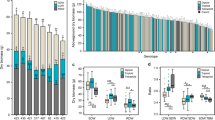Abstract
Heterotic response for total yield among five cultivar-groups of summer squash, Cocozelle, Vegetable Marrow, Zucchini, Crookneck and Straightneck, was studied in two sets of diallel crosses evaluated in two harvest seasons. Each diallel cross included two representatives of each the five cultivar-groups. Griffing and diallel GGE biplot (genotype main effect and interaction) analyses were carried out. The relative importance of the specific combining ability variance on total variance was greater than that reported earlier for intragroup crosses. Highly significant heterosis was manifested only in combinations of Crooknecks or Straightnecks crossed to Cocozelles, Vegetable Marrows or Zucchinis. GGE biplots showed a consistent arrangement where testers of ssp. texana interacted with cultivars of ssp. pepo and vice versa. We propose that the heterotic pattern of texana-pepo crosses could be potentially used to achieve increased yields in hybrids by introgressing one group into another in a manner that would maintain fruit attributes of the cultivar-group.
Similar content being viewed by others
References
Baker, R.J., 1978. Issues in diallel analysis. Crop Sci 18: 533-536.
Bushnell, J.W., 1922. Isolation of uniform types of Hubbard squash by inbreeding. Proc Amer Soc Hort Sci 19: 139-144.
Cress, C.E., 1966. Heterosis of the hybrid related to gene frequency differences between two populations. Genetics 53: 269-274.
Cruz, C.C. & R. Vencovsky, 1989. Comparaç ã o de alguns métodos de análise dialélica. Revista Brasileira de Genética 12: 425-438.
Curtis, L.C., 1939. Heterosis in summer squash (Cucurbita pepo) and the possibilities of producing F1 hybrid seed for commercial planting. Proc Amer Soc Hort Sci 37: 827-828.
Decker, D.S., 1988. Origin(s), evolution, and systematics of Cucurbita pepo (Cucurbitaceae). Economic Botany 42: 4-15.
Dubreuil, P., E. Dufour, E. Krejci, M. Cousse, D. De Vienne, A. Gallais & A. Charcosset, 1996. Organization of RFLP diversity among inbred lines of maize representing the most significant heterotic groups. Crop Sci 36: 790-799.
Elmstrom, G.W., 1978. Evaluation of summer squash varieties for Florida. Proc Fl State Hortic Soc 91: 321-324.
FAO, 2002. Production Yearbook for 2001. Vol. 55. Food and Agriculture Organization of the United Nations, Rome.
Fehr, W.R., 1987. Principles of Cultivar Development. Vol. 1 Theory and Technique. McGraw-Hill Inc., New York.
Firpo, I.T., F.S. Ló pez Anido, S.M. García & E.L. Cointry, 1998. Heterosis in summer squash (Cucurbita pepo L.). Cucurbit Genet Coop Rep 21: 43-45.
Griffing, B., 1956. Concept of general and specific combining ability in relation to diallel crossing systems. Aust J Biol Sci 9: 463-493.
Hallauer, A.R. & J.B. Miranda Filho, 1988. Quantitative Genetics in Maize Breeding. 2nd edn. Iowa State University Press, Ames.
Harrison, K.M., 2002. World trends driving horticulture expansion in emerging economies. Acta Hort 621: 115-125.
Ló pez Anido, F.S., I.T. Firpo, S.M. García & E.L. Cointry, 1998. Combining ability in summer squash (Cucurbita pepo L.). Cucurbit Genet Coop Rep 21: 40-42.
Magari, R. & M.S. Kang, 1994. Interactive BASIC program for Griffing's Diallel analysis. J Hered 85: 336.
Paris, H.S., 1986. A proposed subspecific classification for Cucurbita pepo. Phytologia 61: 133-138.
Paris, H.S., 1989. Historical records, origins, and development of the edible cultivar groups of Cucurbita pepo (Cucurbitaceae). Economic Botany 43: 423-443.
Paris, H.S., 1996. Summer Squash: History, diversity, and distribution. HortTechnology 6: 6-13.
Scott, G.W., 1934. Observations on some inbred lines of bush types of Cucurbita pepo. Proc Amer Soc Hort Sci 32: 480.
Stuber, C.W., 1994. Heterosis in plant breeding. Plant Breed Rev 12: 227-251.
Robinson, R.W. & H.S. Paris, 2000. Cucurbita gene list update. Cucurbit Genet Coop Rep 23: 137-138.
Wehner, T.C., 1999. Heterosis in important US vegetable crops. In: J.G. Coors & S. Pandey (Eds.), The Genetics and Exploitation of Heterosis in Crops, pp. 387-397. ASA-CSSA and SSSA Inc., Madison, Wisconsin.
Whitaker, T.W. & G.N. Davis, 1962. Cucurbits. Interscience Publishers Inc., New York.
Yan, W., 2001. GGEbiplot-a Windows application for graphical analysis of multi-environment trial data and other types of twoway data. Agron J 93: 1111-1118.
Yan, W. & A. Hunt, 2002. Biplot analysis of diallel data. Crop Sci 42: 21-30.
Author information
Authors and Affiliations
Corresponding author
Rights and permissions
About this article
Cite this article
López Anido, F., Cravero, V., Asprelli, P. et al. Heterotic patterns in hybrids involving cultivar-groups of summer squash, Cucurbita pepo L.. Euphytica 135, 355–360 (2004). https://doi.org/10.1023/B:EUPH.0000013373.91446.f3
Issue Date:
DOI: https://doi.org/10.1023/B:EUPH.0000013373.91446.f3




